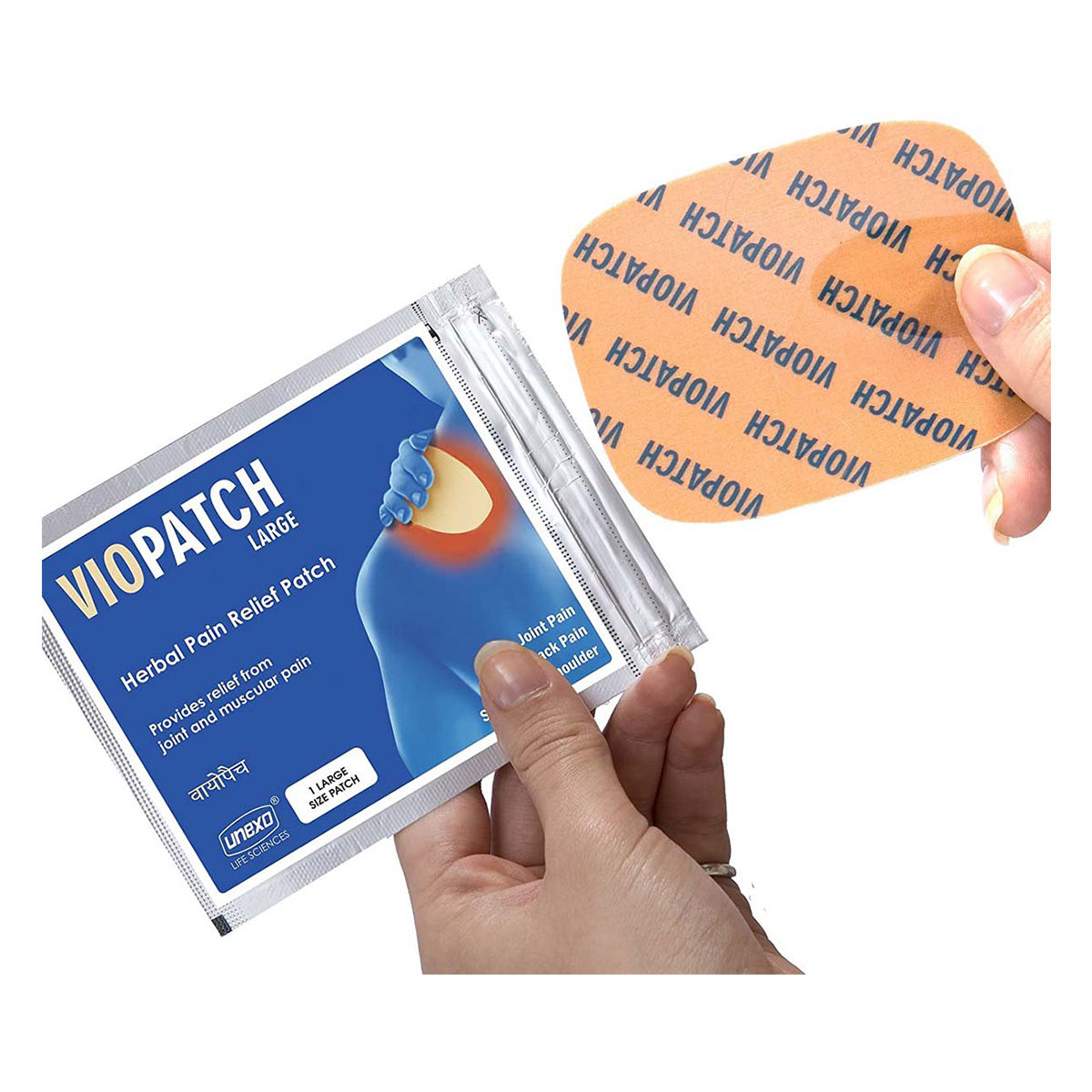Dicloplast Patch 3's



₹169.4*
MRP ₹192.5
12% off
(Inclusive of all Taxes)
GetFREE deliveryon this order with circle membership
Know Your Delivery Time
Provide Delivery Location
Available Offers

Secure Payment

India's Most Trusted Pharmacy

Genuine Products
Composition :
Manufacturer/Marketer :
Consume Type :
Return Policy :
Expires on or after :
About Dicloplast Patch
Dicloplast Patch is used to relieve pain and inflammation associated with musculoskeletal disorders, strain, sprain, arthritis, contusions (bruises), post-traumatic pain, and low back pain. Musculoskeletal pain could occur due to arthritis, osteoporosis, fractures, dislocations, problems with the bone structure or injury to the bones, joints, tendons, muscles, and ligaments.
Dicloplast Patch contains Diclofenac diethylamine, which works by blocking the effect of a chemical messenger known as cyclo-oxygenase (COX) enzymes that make another chemical prostaglandin. By blocking the effect of COX enzymes, fewer prostaglandins are produced; this helps in reducing mild to moderate pain and inflammation at the injured or damaged site.
In some cases, you may experience common side effects such as application site reactions like itching, irritation, redness, and burning sensation. Most of these side effects do not require medical attention and will resolve gradually over time. However, you are advised to talk to your doctor if the side effects persist or worsen.
Dicloplast Patch is for external use only. Notify your doctor if you have had any recent heart surgery. Consult a doctor before using Dicloplast Patch if you are pregnant or breastfeeding. Dicloplast Patch is not recommended for children below 14 years. Avoid using Dicloplast Patch if you are during the perioperative period in the setting of coronary artery bypass graft surgery.
Uses of Dicloplast Patch
Directions for Use
Key Benefits
Dicloplast Patch is used to relieve pain and inflammation associated with musculoskeletal disorders, strain, sprain, arthritis, and low back pain. Dicloplast Patch works by blocking the effect of a chemical messenger known as cyclo-oxygenase (COX) enzymes that make other chemical prostaglandins. By blocking the effect of COX enzymes, lesser prostaglandins are produced, which reduces mild to moderate pain and inflammation at the injured or damaged site.
How Dicloplast Patch Works
Storage
Side Effects of Dicloplast Patch
- Itching
- Irritation
- Redness
- Eczema
What if I have taken an overdose of Dicloplast Patch
Drug Warnings
Do not use Dicloplast Patch if you are allergic to any of its contents, if you are hypersensitive to NSAIDs, or if you have kidney failure. Avoid using Dicloplast Patch if you are during the perioperative period in the setting of coronary artery bypass graft surgery. Dicloplast Patch may increase the risk of a fatal heart attack or stroke. So, if you have had any recent heart surgery, do not use Dicloplast Patch. Inform your doctor if you have peptic ulcers, heart surgery, high blood pressure, high cholesterol, diabetes, stomach ulcers, bleeding problems, asthma, fluid retention, inflammatory bowel disease, kidney or liver problems. Consult a doctor if you are pregnant or breastfeeding. Dicloplast Patch is not recommended for children below 14 years.
Drug-Drug Interactions
Drug-Drug Interactions
Login/Sign Up
Co-administration of Dicloplast Patch with Meloxicam can increase the risk or severity of gastrointestinal side effects.
How to manage the interaction:
Taking Meloxicam with Dicloplast Patch is not recommended as it can possibly result in an interaction, it can be taken if your doctor has advised it. However, consult your doctor immediately if you experience symptoms such as dizziness, lightheadedness, red or black, tarry stools, coughing up or vomiting fresh or dried blood that looks like coffee grounds, severe headache, and weakness. Do not stop any medication without doctor's advise.
Taking Dicloplast Patch with human immunoglobulin may increase the risk of kidney problems.
How to manage the interaction:
Although there is an interaction between Human immunoglobulin and Dicloplast Patch, you can take these medicines together if prescribed by a doctor. However, consult the doctor immediately if you experience symptoms such as nausea, vomiting, loss of appetite, increased or decreased urination, sudden weight gain or weight loss, fluid retention, swelling, shortness of breath, muscle cramps, tiredness, weakness, dizziness, confusion, and irregular heart rhythm. Do not discontinue any medications without consulting a doctor.
Co-administration of Dicloplast Patch with tenofovir disoproxil may increase the risk of developing kidney problems.
How to manage the interaction:
There may be a possible interaction between Dicloplast Patch and Tenofovir disoproxil but they can be taken together if your doctor has prescribed them. However consult your doctor immediately if you experience symptoms such as such as nausea, vomiting, loss of appetite, increased or decreased urination, sudden weight gain or weight loss, swelling, shortness of breath, bone pain, muscle cramps, tiredness, weakness, dizziness, confusion, and irregular heart rhythm. Do not stop using any medications without first talking to your doctor.
Coadministration of Dicloplast Patch and Naproxen can increase the risk or severity of side effects.
How to manage the interaction:
Taking Dicloplast Patch and Naproxen together can possibly result in an interaction, it can be taken if your doctor has advised it. However, if you notice any unusual bleeding or bruising, other signs of bleeding, dizziness, lightheadedness, red or black tarry stools, coughing up or vomiting blood, severe headache, and weakness, you should contact your doctor immediately. Do not stop using any medications without first talking to your doctor.
Taking amiloride with Dicloplast Patch can increase the risk of kidney problems, hyperkalemia(high potassium levels in blood), and high blood pressure.
How to manage the interaction:
There could be a possible interaction between Dicloplast Patch and amiloride, but they can be taken together if your doctor has prescribed them. However, if you experience any unusual symptoms contact your doctor immediately. Do not stop using any medications without first talking to your doctor.
Concomitant administration of Dicloplast Patch and furosemide may decrease the therapeutic efficacy of furosemide and adversely affect renal function.
How to manage the interaction:
There may be a possible interaction between Dicloplast Patch and furosemide, but they can be taken together if your doctor has prescribed them. However, consult your doctor immediately if you experience symptoms like nausea, dizziness, irregular heartbeats, altered blood pressure, tingling. Do not stop using any medications without first talking to your doctor.
Co-administration of methotrexate with Dicloplast Patch can increase the levels and effects of methotrexate. This can lead to increased risk of side effects.
How to manage the interaction:
Although there is a possible interaction between methotrexate and Dicloplast Patch, you can take these medicines together if prescribed by your doctor. However, if you experience any symptoms such as mouth sores or ulcers, nausea, vomiting, diarrhea, rash, loss of hunger, joint pain or swelling, yellowing of the skin or eyes, dark urine, shortness of breath, a dry cough, paleness, dizziness or fainting, unusual bruising or bleeding, fits, infection, fever, chills, body aches, sore throat or muscle weakness, consult a doctor immediately. Do not stop using medications without a doctor's advice.
Taking Dicloplast Patch and piroxicam can increase the risk of side effects such as ulcers, inflammation (redness, swelling), bleeding.
How to manage the interaction:
Co-administration of Dicloplast Patch and Piroxicam can lead to an interaction, it can be taken if advised by a doctor. However, if you experience any symptoms like unusual bleeding or bruising, dizziness, lightheadedness, red or black, tarry stools, coughing up or vomiting fresh or dried blood that looks like coffee grounds, severe headache, and weakness, consult a doctor immediately. Do not stop using any medications without a doctor's advice.
Taking acalabrutinib together with Dicloplast Patch may increase the risk of bleeding.
How to manage the interaction:
Co-administration of Dicloplast Patch and Acalabrutinib can lead to an interaction; it can be taken if advised by your doctor. However, if you experience any symptoms like unusual bleeding or bruising, dizziness, lightheadedness, red or black, tarry stools, coughing up or vomiting fresh or dried blood that looks like coffee grounds, severe headache, and weakness, consult your doctor immediately. Do not stop using any medications without a doctor's advice.
Co-administration of Dicloplast Patch and sulindac can increase the risk of side effects.
How to manage the interaction:
Although there is a interaction between Dicloplast Patch and sulindac, it can be taken if advised by your doctor. However, if you experience any symptoms like unusual bleeding or bruising, dizziness, lightheadedness, red or black, tarry stools, coughing up or vomiting fresh or dried blood that looks like coffee grounds, severe headache, and weakness, consult your doctor immediately. Do not stop using any medications without a doctor's advice.
Drug-Food Interactions
Drug-Food Interactions
Login/Sign Up
Diet & Lifestyle Advise
Physical activity helps in strengthening muscles and relieves joint stiffness. Gentle activities like 20-30minutes of walking or swimming would be helpful.
Performing yoga may also help in improving joint flexibility and pain management.
Maintain a healthy weight by performing regular low-strain exercises and eating healthy food.
Get adequate sleep as resting the muscles can help in reducing inflammation and swelling.
De-stress yourself by meditating, reading books, taking a warm bubble bath or listening to soothing music.
Acupuncture, massage and physical therapy may also be helpful.
Eat food rich in antioxidants such as berries, spinach, kidney beans, dark chocolate, etc.
Foods containing flavonoids help in reducing inflammation. These include soy, berries, broccoli, grapes and green tea.
Avoid smoking and alcohol consumption.
Habit Forming
Therapeutic Class
Dicloplast Patch Substitute

Powergesic 100mg Transdermal Patch 3's
by AYUR
₹56.10per tabletDicloplast Patches 10's
by Others
₹19.25per tablet
Product Substitutes
Alcohol
Caution
Avoid alcohol consumption as it might increase the risk of stomach bleeding.
Pregnancy
Caution
Please consult your doctor if you have any concerns regarding this; your doctor will prescribe only if the benefits outweigh the risks. Dicloplast Patch should not be used during the last trimester of pregnancy.
Breast Feeding
Caution
Consult your doctor if you are breastfeeding; your doctor will decide whether Dicloplast Patch can be used by breastfeeding mothers or not. If you are breastfeeding, avoid applying Dicloplast Patch on your breast.
Driving
Safe if prescribed
Dicloplast Patch is unlikely to affect your ability to drive.
Liver
Caution
Please consult your doctor if you have a liver impairment or any concerns regarding this.
Kidney
Caution
Please consult your doctor if you have kidney impairment or any concerns regarding this. Avoid using Dicloplast Patch if you have kidney failure.
Children
Unsafe
Dicloplast Patch is not recommended for children below 14 years as safety and effectiveness have not been established.
FAQs
Dicloplast Patch is used to relieve pain and inflammation associated with musculoskeletal disorders, strain, sprain, arthritis, contusions (bruises), post-traumatic pain, and low back pain.
Dicloplast Patch works by blocking the effect of chemical messengers that cause pain and inflammation at the injured or damaged site. Thereby, Dicloplast Patch helps in providing relief from pain.
Dicloplast Patch is used to reduce and relieve pain and inflammation associated with osteoarthritis. It is a joint disease in which the two ends of the joints come together due to the breakdown of a protective covering called cartilage.
Avoid concomitant use of Dicloplast Patch with other topical products such as cosmetics, sunscreens, lotions, moisturisers, insect repellent creams, and other gels.
Do not apply external heat or cover the treated skin with dressings after applying Dicloplast Patch. Covering the skin or applying heat might increase the amount of drugs absorbed into the skin leading to unpleasant side effects.
Do not apply Dicloplast Patch on wounds, skin injuries, irritated skin, skin abrasions, rashes, and infections. Apply Dicloplast Patch on healthy skin only.
Avoid using Dicloplast Patch for longer durations unless prescribed by the doctor. The duration depends upon the response to the treatment. If your condition does not improve despite using Dicloplast Patch for 7 days, consult a doctor.
Country of origin
Manufacturer/Marketer address
Alternatives
Similar Products
Disclaimer
Author Details
We provide you with authentic, trustworthy and relevant information



















